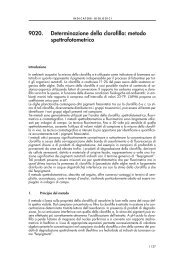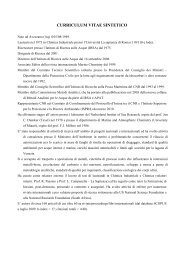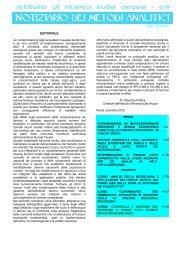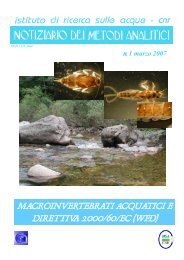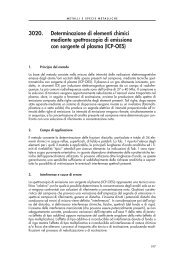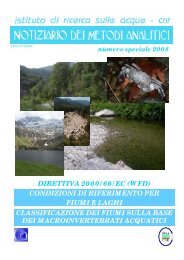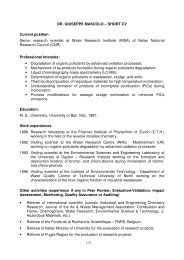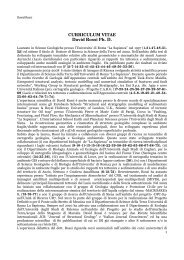The Nanga Parbat-Haramosh Monitoring Network - IRSA - Cnr
The Nanga Parbat-Haramosh Monitoring Network - IRSA - Cnr
The Nanga Parbat-Haramosh Monitoring Network - IRSA - Cnr
You also want an ePaper? Increase the reach of your titles
YUMPU automatically turns print PDFs into web optimized ePapers that Google loves.
<strong>The</strong> present study presents the preliminary results of a first survey consequent to<br />
the recent installation (2009) of GNSS network including three permanent GNSS stations<br />
between Islamabad and the Northern Areas of Pakistan and four points located on the<br />
<strong>Nanga</strong> <strong>Parbat</strong> – <strong>Haramosh</strong> massif.<br />
Since a permanent GPS station was located near the Pyramid Laboratory at<br />
Lobuche in the Khumbu region in 1994 providing long records of data during the last 15<br />
years, the goal of the project is to compare data obtained from Everest with the ones from<br />
<strong>Nanga</strong> <strong>Parbat</strong> in order to evaluate, not only the total uplift (if quantifiable) of the two<br />
massifs, but also the direction of the crustal movements.<br />
Regional Geology and Plate Tectonic Setting<br />
Northern Pakistan comprises three former distinct and previously apart plates<br />
named Karakoram, Kohistan and Indian. <strong>The</strong>se Plates collided with each other during<br />
Cretaceous-Tertiary ages and formed the present day configuration of this region<br />
(Tahirkheli et al., 1982; Coward et al., 1987). This collisional tectonics and mountainbuilding<br />
activity is termed Himalayan orgogeny being the result of continent-arc-continent<br />
collision. <strong>The</strong> Kohistan Island Arc is sutured to the Karakoram Block (Shyok Suture) in the<br />
north along MKT (Main Karakoram Thrust) and to the Indian Plate (Indus-Tsangpo Suture)<br />
in the south. <strong>The</strong> tectonics of Kohistan is related to collisional tectonics of Hindu Kush,<br />
Karakoram and Himalayan Ranges which involve Indian Plate with <strong>Nanga</strong> <strong>Parbat</strong>-<br />
<strong>Haramosh</strong> Massif, Karakoram Block and in between sandwiched Kohistan Arc.<br />
Geology of the <strong>Nanga</strong> <strong>Parbat</strong> area<br />
<strong>Nanga</strong> <strong>Parbat</strong>–<strong>Haramosh</strong> massif is delimitated by two thrust-displacement shear<br />
zones that have a spatial and temporal link with granite plutonism from ca. 10 to 1 Ma. <strong>The</strong><br />
shear zones define a crustal-scale antiformal pop-up structure, with dominant westnorthwest–vergent<br />
and subordinate east-southeast–vergent thrusting. This is substantially<br />
different than the surrounding area where the main exposed Himalayan structures are<br />
oriented parallel to the orogenic trend and are early to middle Miocene or older (Schneider<br />
et al., 1997). <strong>The</strong> western Himalaya syntaxis includes the <strong>Nanga</strong> <strong>Parbat</strong>–<strong>Haramosh</strong><br />
massif, a now exposed section of largely Proterozoic Indian plate crust, initially<br />
overthrusted by Cretaceous island arc rocks along the Main Mantle thrust. <strong>Nanga</strong> <strong>Parbat</strong> is<br />
an area of extreme relief that has undergone rapid exhumation since 10 Ma (e.g., Zeitler<br />
P., 1985), exposing migmatites and granulitegrade rocks at the core of the massif (Smith<br />
H.A. et al., 1992). <strong>Nanga</strong> <strong>Parbat</strong> syntaxis comprises three major rock units: a) Iskhere-<br />
Mushkin-Rupal Gneiss; b) Shengus-Harchu Gneiss; and <strong>Haramosh</strong>-Tarshing Schists. A<br />
wide range of rocks intruding these major lithological units has been noticed in nearly all of<br />
<strong>Nanga</strong> <strong>Parbat</strong> synaxial region, which included basic dykes and a wide variety of granites.<br />
<strong>The</strong> younger phases of granite up to 0.75 Ma are intruding the <strong>Nanga</strong> <strong>Parbat</strong> Gneisses.<br />
<strong>The</strong> survey of the Mt. Everest mountain range<br />
Fifteen years (unfortunately not continuous) of observations with a permanent GPS<br />
station at the Ev-K2-CNR Pyramid Laboratory allow to determine the precise direction of<br />
the tectonic movement of the Mt. Everest area. Taking into account several time intervals<br />
2




